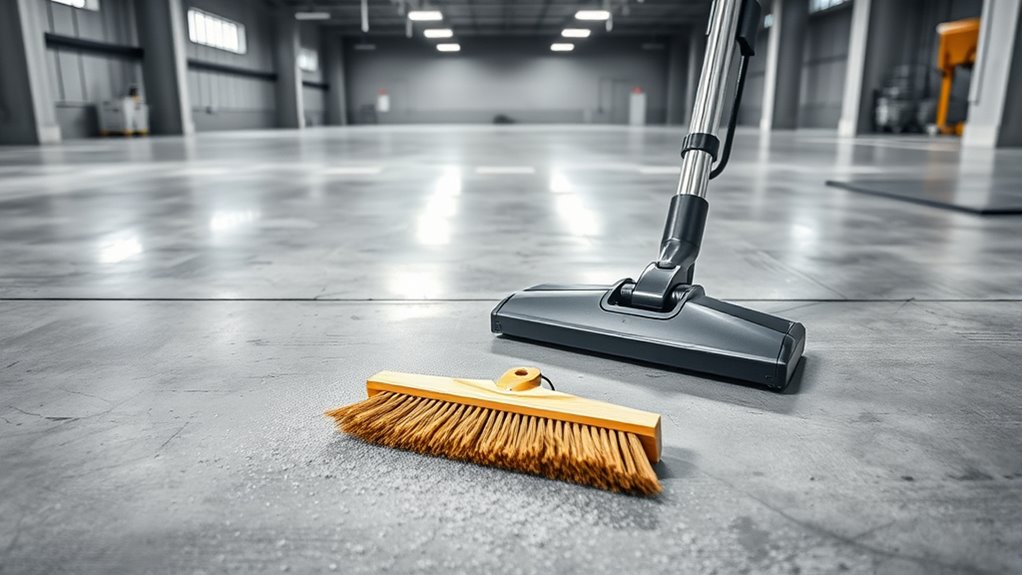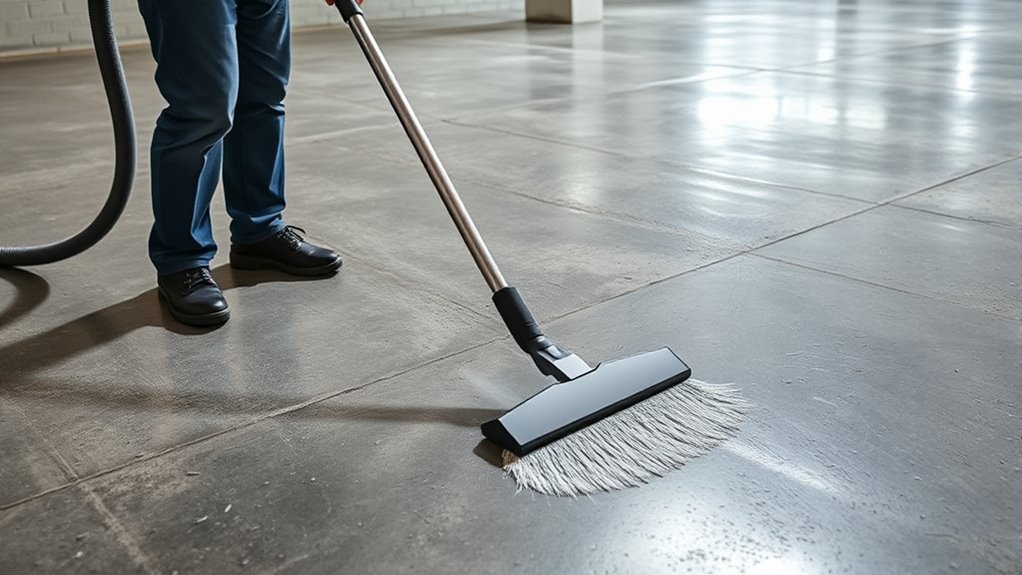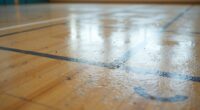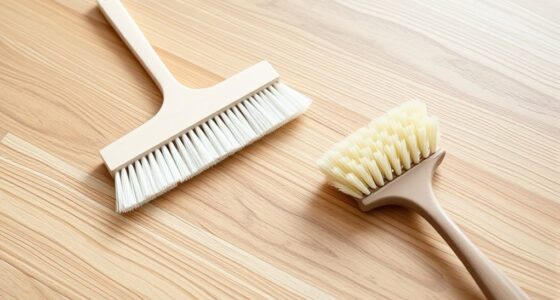For concrete floors, use sweeping for larger debris like gravel or concrete chunks, as it’s quick and cost-effective. Vacuuming, especially with HEPA filters, is better for picking up fine dust and dirt, helping improve air quality and protect equipment. Combining both methods provides a thorough clean suited to different debris types and guarantees a healthier, more efficient environment. Keep exploring to discover the best tips for your cleaning needs.
Key Takeaways
- Use sweeping for quick removal of large debris and open areas on concrete floors.
- Choose vacuuming, especially with HEPA filters, for fine dust and detailed cleaning.
- Combine sweeping and vacuuming to maximize cleanliness and dust control on concrete surfaces.
- Consider debris size and location to select the most efficient tool—brooms for heavy debris, vacuums for dust.
- Regular maintenance of both tools ensures optimal performance and extends their lifespan.

When it comes to keeping concrete floors clean, deciding whether to sweep or vacuum can make a big difference. Your choice impacts not just cleanliness, but also dust control and the longevity of your equipment. Sweeping is a tried-and-true method that works well for large, open spaces. It’s quick, requires minimal setup, and allows you to cover ground efficiently. However, if dust control is a priority—say, for health reasons or to prevent dust from settling into machinery—vacuuming might be the better option. A good industrial vacuum can trap fine dust particles that sweeping might kick back into the air, reducing airborne dust and keeping your workspace cleaner and healthier.
Choosing the right tool also affects equipment maintenance. Regular sweeping can help prevent debris from accumulating and causing damage or wear to floors and machinery. But if you rely solely on sweeping, you might miss fine dust particles that can settle into cracks or get blown around, leading to long-term issues. Using a vacuum with a HEPA filter can trap these microscopic particles, ensuring your equipment stays cleaner and functions more efficiently. This reduces the need for frequent repairs and prolongs the lifespan of your machinery. Plus, vacuuming requires less physical effort and can be less disruptive to your workflow, especially if you need to quickly clean up after work shifts or during breaks.
Using HEPA-filtered vacuums reduces long-term equipment wear and simplifies cleaning routines.
Another consideration is the type of debris you’re dealing with. Larger debris like gravel or chunks of concrete are easier to handle with a broom or push broom because they can be swept away swiftly. Fine dust, on the other hand, is better removed with a vacuum cleaner that’s designed for dust control. Investing in proper maintenance of your equipment is vital—regularly checking and cleaning your vacuums or brooms ensures they perform at their best and don’t spread dirt around. Well-maintained equipment not only improves cleaning efficiency but also extends its lifespan, saving you money in the long run. Additionally, selecting the right vacuum technology can make a significant difference in dust management and overall cleaning effectiveness.
Ultimately, the decision comes down to your specific needs. If you’re dealing with heavy debris and need a quick cleanup, sweeping might be your go-to. But for environments where dust control is essential or where fine dust can cause problems, vacuuming is the smarter choice. Combining both methods can often give you the best results—sweeping to remove large debris and vacuuming for detailed dust removal—ensuring your concrete floors stay clean, safe, and well-maintained.
Frequently Asked Questions
Can I Use a Standard Household Vacuum on Concrete Floors?
You can use a household vacuum on concrete floors, but it might not be the best choice. Standard household vacuums are designed for carpets and lightweight debris, so they may struggle with concrete’s durability and rough surface. For better results, consider using a heavy-duty vacuum or a broom, especially for larger debris. This guarantees you clean efficiently without damaging your vacuum or missing dirt on your concrete floors.
How Often Should I Sweep or Vacuum Concrete Floors?
You should sweep or vacuum your concrete floors at least once a week to keep them in top shape. Regular cleaning prevents dust and debris from piling up and causing wear. For high-traffic areas, consider more frequent maintenance, like twice a week. Follow proper cleaning frequency and maintenance tips, such as using the right tools, to prolong your floor’s lifespan. It’s better to stay ahead than to chase after dirt.
Are There Specific Vacuums Designed for Industrial Concrete Cleaning?
Yes, there are specific vacuums designed for industrial concrete cleaning. These industrial vacuum features include powerful motors, durable filters, and heavy-duty construction, making them ideal for tough debris and dust. They are part of commercial cleaning equipment, ensuring efficient and thorough cleaning in industrial settings. Choosing a vacuum with these features helps you effectively maintain concrete floors, preventing buildup and prolonging their lifespan.
What Are the Best Broom Types for Different Concrete Surfaces?
For different concrete surfaces, you should choose broom bristle types that match the texture. For smooth concrete, opt for soft or fine bristles to avoid scratching. Medium bristles work well for slightly textured surfaces, while stiff bristles are ideal for rough, uneven concrete. You actively select the right broom based on the concrete surface textures, ensuring effective cleaning without damage, and making your task easier and more efficient.
Does Vacuuming Damage Sealed Concrete Floors?
In the age of steam engines, you might worry about damaging sealed concrete floors with a vacuum. Rest assured, most vacuums are safe if they’re compatible with your floor’s sealant and aren’t too heavy. Choose a lightweight vacuum designed for delicate surfaces, and verify it’s compatible with your floor sealant. Properly maintained, vacuuming won’t harm your sealed concrete and can effectively pick up dust without scratches.
Conclusion
Remember, a job worth doing is worth doing well. Whether you choose to sweep or vacuum your concrete floors, pick the tool that best fits your needs and keep your space clean. Regular maintenance not only prolongs your floors’ life but also keeps your environment healthier. So, weigh your options carefully, and don’t put off the task. After all, a clean floor is the foundation of a tidy home or workspace.









